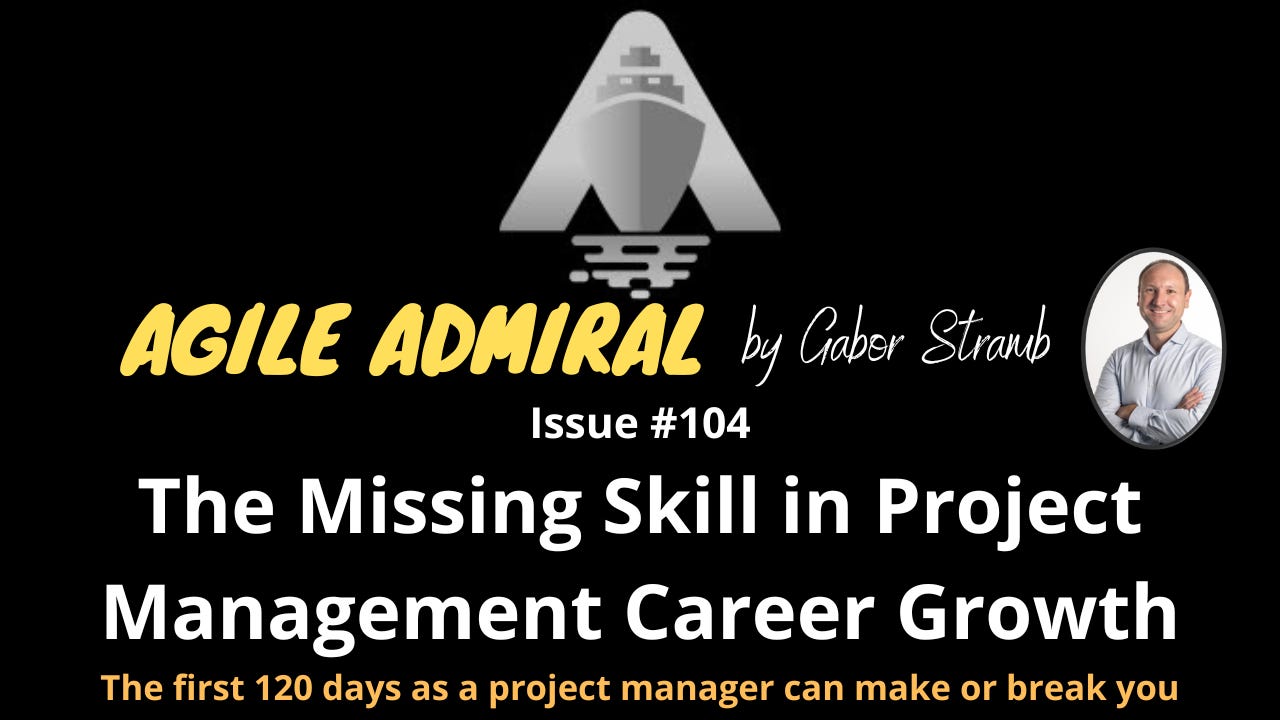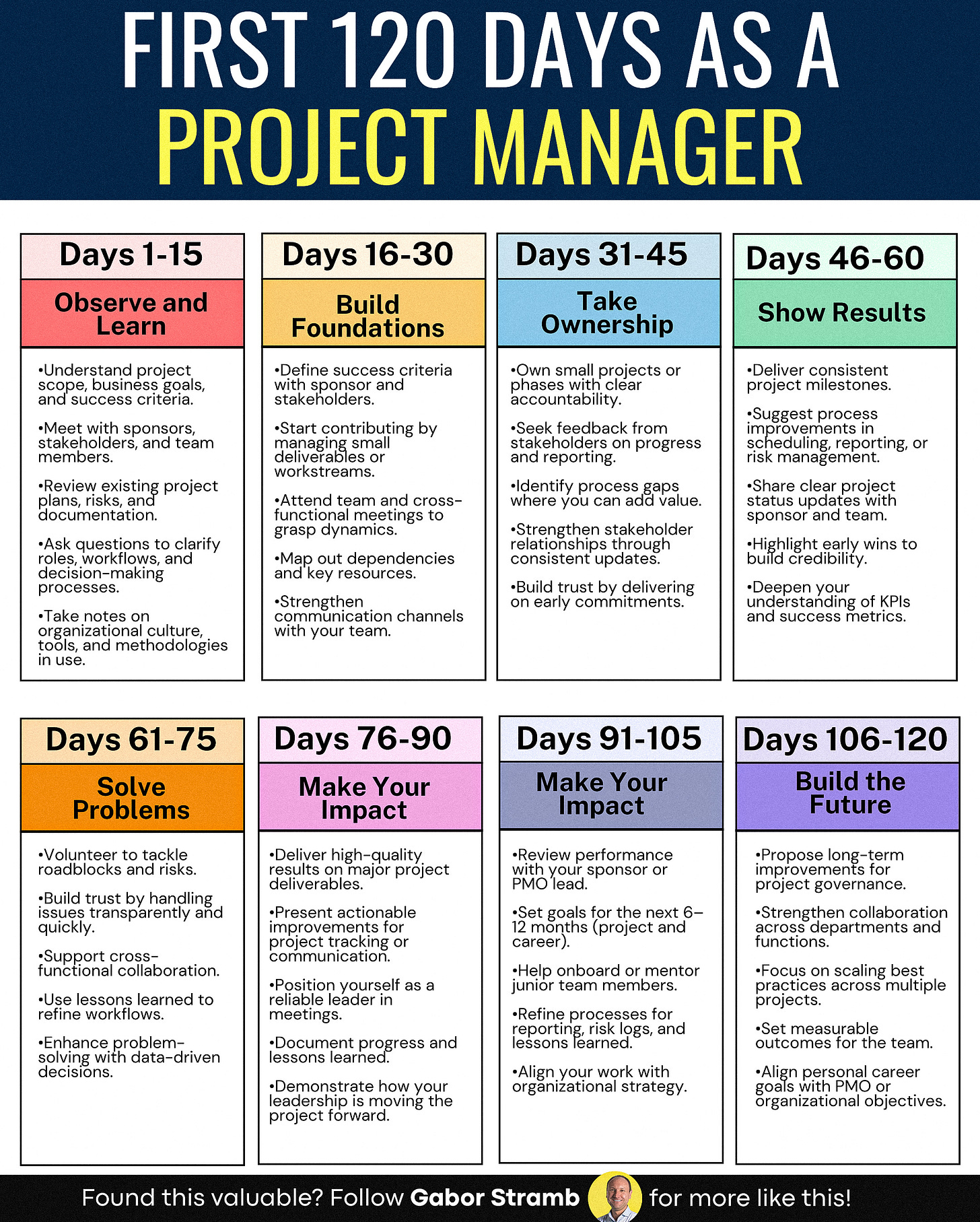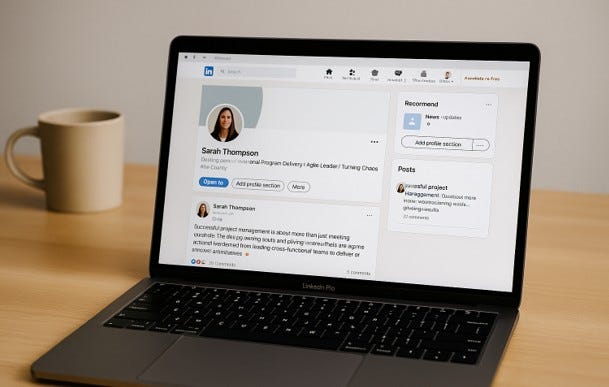The Missing Skill in Project Management Career Growth
The first 120 days as a project manager can make or break you
A 5-minute read for experienced project managers ready to elevate their impact
Welcome to the Agile Admiral weekly newsletter. Your Essential Resource for Project Management Excellence.
Each week, I tackle reader questions about PMP preparation, how to implement PMP into real-life projects, and a Senior Project Manager career.
If you’re new here, check these:
PMP Espresso - Hybrid Projects - Video | When Projects Turn Red: Navigating the Wave When It Hits | Junior vs Senior Project Manager | You cannot prevent all conflicts | How to fill PMP application? | Change Management in Medical IT
What’s Inside This Edition:
The first 120 days as a project manager can make or break you
Thought Leadership by IIL
Strategic Visibility: The Missing Skill in Project Management Career Growth
You either earn trust and set the tone for your career.
Or you get labeled as someone who cannot deliver.
Here is how the best PMs structure those first 4 months:
IPM Day 2025
Thought Leadership
In this week’s edition, we shift the focus to empowerment, showing you how to take proactive ownership of your career, well-being, and influence. Discover how to turn overlooked gaps in your day into powerful opportunities for growth and self-care by Making the Most of Your Transit Time. We then tackle the modern project manager’s greatest challenge with Don’t Wait for Permission, an article urging you to step into the authority void, lead proactively, and create influence through action rather than waiting for a title.
This empowerment theme flows naturally into a spotlight on Gratitude, Appreciation, Acknowledgment and Recognition, revealing how these fundamental soft skills form the Heart of International Project Management Day 2025 and act as core drivers for team engagement and performance.
We also give you an inside look at the experts and sessions in the Spotlight: Leadership and Soft Skills Speakers at IIL’s IPM Day 2025, proving that strengthening your human dynamics is critical for success in an automated world. Finally, explore the newest strategic challenges facing our industry with the latest installment of our Blog Series: The Impact of AI on Project, Program, and Portfolio Management.
Plus, be sure to check out our latest hot courses and free webinars to keep your skills sharp.
Strategic Visibility
The Missing Skill in Project Management Career Growth
By Elizabeth Dworkin, Peak Transformation Services, LLC,
PM Career Coach and Visibility Strategist
Project and program management often feel like silent roles. You’re behind the curtain, navigating chaos, aligning stakeholders, clearing roadblocks, and keeping the ship afloat. When everything goes smoothly, no one notices. That’s the job. When things fall apart, suddenly all eyes are on you.
It’s a paradox many project leaders know too well: if you’re doing your job well, your work becomes invisible. But in a world that rewards visibility, how do you grow your career without waiting for a crisis to prove your worth?
That’s where strategic visibility comes in. It’s not about self-promotion for the sake of ego. It’s about intentionally surfacing your impact, in the room, online, and on paper, so your work, leadership, and value are not only seen, but recognized.
Let’s break that down.
Why Strategic Visibility Matters?
The truth is, your career doesn’t grow based on how hard you work. It grows based on how visible your impact is. Promotions, new roles, exciting opportunities…they all stem from how others perceive your contribution.
In project management, where the work is often facilitative, behind-the-scenes, or cross-functional, it’s easy to get overlooked. Unless you make your value legible to others, especially decision-makers, you risk getting stuck in the same role year after year.
Strategic visibility is about reframing your narrative. It means showing the impact of your work, not just the activities. Instead of “ran weekly status meetings,” it becomes “led strategic alignment sessions that accelerated delivery by 3 weeks.” The work didn’t change, but the perception did.
The Three Channels of Visibility
Think of your visibility as a three-channel system:
In the Room
Online
On Paper
Each of these channels presents different opportunities to signal your impact, influence perception, and advance your career.
1. In the Room: Own Your Voice Where It Matters
“In the room” visibility is about being seen and heard in the environments that shape your career, whether it’s your current role, stakeholder meetings, executive reviews, or even job interviews.
This is often where project managers struggle most. We’re trained to elevate the team, defer to stakeholders, and keep things moving. But leadership visibility doesn’t require ego, it requires presence.
Tips for visibility in the room:
Surface tradeoffs and raise risks early: Visibility doesn’t just come from progress updates, it comes from helping the room make better decisions. Flagging when a scope change impacts the timeline, when a technical risk needs attention, or when two options have downstream consequences is leadership. It shows you’re not just tracking the work, you’re steering it.
Frame your updates in terms of business value: Instead of listing tasks, connect updates to outcomes. For example: “We’re tracking 92% on-time delivery, which directly supports the Q4 customer retention goal.” Make the impact explicit.
Speak up strategically: Ask clarifying questions, offer insights from the team’s perspective, and connect conversations to business priorities. These actions shift your presence from executor to strategic partner.
Practice your story for interviews: Whether you’re in a performance review or a job interview, your job is to translate your work into value. Use structured storytelling (Situation – Action – Impact) to demonstrate not just what you did, but what changed because of you.
Being visible in the room isn’t about dominating the conversation. It’s about making the conversation smarter, more forward-looking, and more tied to impact. People don’t promote project managers who do a lot. They promote project managers who drive the business forward.
2. Online: Curate a Leadership Brand
LinkedIn and other professional platforms aren’t just for job seekers, but also thought leaders. As a project or program manager, your online presence can signal your leadership style, your domain expertise, and your growth trajectory.
It’s not about becoming an influencer. It’s about positioning yourself intentionally.
How to build online visibility:
Update your headline and About section: Instead of just “Senior Project Manager,” try “Driving Cross-Functional Program Delivery | Agile Leader | Turning Chaos into Clarity.” Show your value.
Share insights from your work: Post lessons learned after retrospectives, reflections on stakeholder management, or articles you’ve written. These posts show you think beyond tasks, as a leader.
Engage with your network: Comment thoughtfully on others’ posts, celebrate team wins, and connect with professionals in your field. Visibility often grows through conversation, not just content.
A strong online brand helps people remember you not just as “a PM,” but as that PM who brings clarity, drives value, and leads with intention.
3. On Paper: Translate Work into Impact
Use active, impact-driven language: Start with verbs like “Led,” “Delivered,” “Optimized,” “Transformed,” and pair them with measurable results: “Reduced project delivery time by 18% through Agile sprint optimization.”
Quantify wherever possible: If you’ve led $2M programs, shortened timelines, improved team velocity, or reduced risk, say it. Numbers catch attention.
Tailor for the role you want: If you’re aiming for a program management role, highlight cross-functional strategy, stakeholder leadership, and business alignment, not just task execution.
Think of your resume and profiles not as a history of your work, but as a business case for your next opportunity.
Strategic Visibility Is a Daily Practice
You don’t need to shout to be visible. Strategic visibility is about weaving visibility into your everyday updates, documentation, and conversations.
Every status report is a chance to tell a story about progress and business value. Every team meeting is a stage to clarify priorities and surface risks with confidence. Every LinkedIn post is a window into how you think as a leader.
This isn’t about changing who you are. It’s about changing how others see who you are.
Final Thoughts: Don’t Let Good Work Go Unseen
If you’re a project or program manager who feels like your work speaks for itself, know this: in many rooms, your work is not fluent. You need to translate it. You need to surface it. You need to own it.
Strategic visibility is not self-promotion. It’s leadership communication. It’s how you grow influence, earn trust, and take your seat at the table.
So, the next time you think, “I’m just doing my job,” ask yourself: Does the right person know the impact it made?
Because in today’s world, doing great work is the start. Being seen as a strategic driver of value? That’s what moves your career forward.
_______________
If you need help to become strategically visible, please reach out to Elizabeth Dworkin.
See you next week.
Follow me on LinkedIn | YouTube | Instagram
If we are not connected via LinkedIn, click here → LinkedIn
PMP prep is not a walk in the park. An average student spends 4 to 6 months in exam prep. There is a different way of doing this, and I’m happy to show you “how”. When you’re ready, follow the links below:
👉🏼Do it together - join the PMP Operation System
👉🏼Do it 1-on-1 - join 8-week coaching program
https://gaborstramb.com/special-offer







